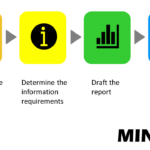
- September 19, 2022
- Marnix Jansen
- Power BI
#Powerbi-users can actually be divided into four different roles. Read all about them in this article.
Introduction
When talking about "the Power BI user," I find it useful to distinguish between four different types of users. They all need different approaches when it comes to training, guidance, software and licensing. The PL-300 (Power BI) exam requires candidates to distinguish between different roles such as:

And that makes total sense when you look at the bigger picture of data management within an organization, which goes far beyond Power BI to include Database Management, Data Science, Azure Synapse and more.
The four roles
However, I would make a distinction between the professionals who use Power BI.
1 The Power BI engineer
This is the person who performs ETL (Extract-Transform-Load) and designs and develops the data model, including DAX measures. This is a highly technical role because it involves connecting to all kinds of source systems. That includes using all standard connectors, but can also include connecting to different sources via an API or otherwise. Also, when more exotic transformations are needed on the data that are not supported by Power Query's user interface, writing the M-code to perform these transformations is part of the engineer's role.
The Power BI data model is best modeled in a dimensional structure. This requires the engineer to have sufficient theoretical knowledge of and experience in dividing the world of data between facts and dimensions in a variety of scenarios. Writing DAX code to produce the required measures also requires sufficient knowledge and experience.
The result of the engineer's work is a data set that serves as input for the data analyst.
2 The data analyst
The data analyst is the person who takes the data set developed by the engineer as input and explores and analyzes the data in it. An analyst would do this by segmenting quantitative data in the fact tables and analyzing it by applying filters to the dimension tables. This enables all kinds of insights into the data. Power BI also helps with data analysis by providing artificial intelligence through a number of AI visual functions.
The goal of the data analyst is to find hidden insights into the data that tell the story behind an organization's numbers.
To communicate these insights, a data analyst needs strong data visualization skills. Ensuring that the information presented on the report effectively meets the information needs of report users, choosing the right visuals and ensuring effective distribution in the Power BI service are all part of the job.
The result of the data analyst is a report that serves as input for the report user.
3 Report user
The report user is a person with business responsibilities and wants to base decisions on facts rather than assumptions. Therefore, the report user takes the Power BI report as input and bases business decisions on the information presented in it. A report user should not require a background in data analysis because a Power BI report should be tailored to the report user. All that is needed is some end-user training, which should not take more than a few hours. Drilling, up, down, through, hovering over visuals and setting slicers are all relatively easy for the report user to do.
4 Power BI administrator
Last but certainly not least is the Power BI administrator who manages the use of Power BI within an organization. This is the person in control of all tenant-level Power BI settings, creating workspaces and apps, access management and more. Depending on the size of an organization, centralized Power BI responsibilities can grow to include production of centralized data sets, creation of a Power BI community, Center of Excellence, setting up a help desk and more.
Roles may differ based on the size of an organization
For small organizations just starting to use Power BI, this is usually done by one enthusiastic person. In such a scenario, of course, no distinction is yet made as described above, and that person will likely be responsible for all four roles without being aware of it. As organizations grow, report users within the company increasingly rely on analysts to produce reports for them. However, it is quite common for the roles of engineer and data analyst to be performed by the same person, even in larger organizations. Without being aware of it, however, these individuals take responsibility for both roles and therefore should be able to perform both. Only in large organizations have I encountered situations where engineers produce and publish a dataset without a report on top of it to enable data analysts to use it as input for their work. The role of the Power BI administrator will also grow and mature as the size of an organization increases and the extent to which Power BI is used.
Categories
- Excel (1)
- Power Apps (2)
- Power BI (18)
- Power BI DAX (10)
- Power BI Query Editor (2)
- Project Management (2)
- Tabular Editor (1)
Recent Posts
-
You have completed your Power BI report,
Jun 28, 2023
 When you start a new report
When you start a new reportJun 28, 2023
Soft skills are more important than hard onesJun 28, 2023
 Combine multiple Excel sheets
Combine multiple Excel sheetsMay 05, 2023




